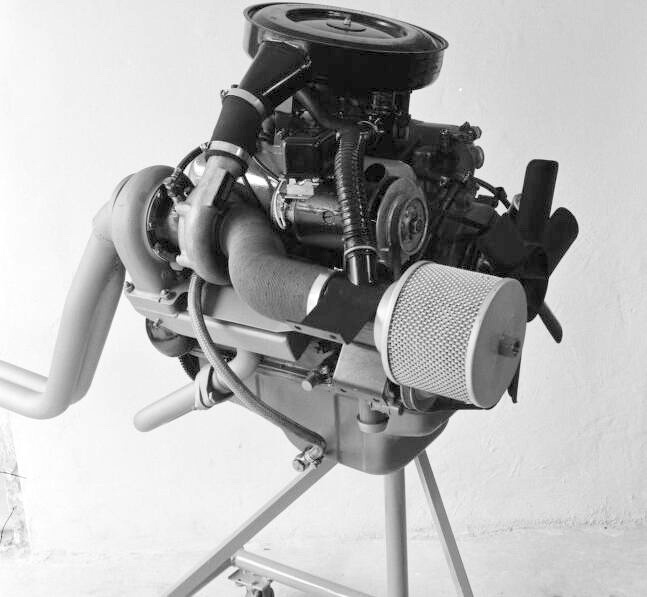|
|
|
| Capri I 2300 GT mit May Turbolader - Die sanfte Gewalt mit Turbo May Aufladung |

Teil / Part 4 - Wie arbeitet der May Turbolader
? |
Für den Einbau einer Turbo-May Anlage wird eine
spezielle Turbolader Gruppe benötigt, die von Dieselmotoren
abgeleitet wurde.
Das Problem der zu hohen Abgastemperatur wird durch eine
vorherige Abkühlung der Auspuffanlage eleminiert.
Die Ladegruppe sitzt an der rechten Motorseite. Die Auspuffgase
der linken Zylinderreihe werden unter dem Motor hindurch
über ein langes Rohr in ein Auspuffsammelrohr aller
6 Zylinder auf der rechten Motorseite geführt. In
dem langem, quer zur Fahrtrichtung liegenden Verbindungsrohr
wird die Hälfte der gesammten Abgase derartig abgekühlt,
dass sich im Sammelrohr eine Mischtemperatur
von ca. 700 Grad C einstellt, die die Dauerbetriebstemperatur
der Turbine darstellt.
Die Abgase verlassen das Turbinengehäuse axial nach
hinten durch ein spezielles Auspuffrohr, das die serienmässige
Auspuffanlage ersetzt.
Die Turbolader Gruppe stellt ein sehr kompaktes Aggregat
dar, was durch die bei
Gasströmungsmaschinen verwendbaren
hohen Drehzahlen (hier 30'000 - 100'000 U/Min.) möglich
ist.
Der in Fahrtrichtung vor der Turbine mit dieser auf einer
gemeinsamen Welle sitzender Lader saugt durch einen Luftfilter
die atmosphärische Luft axial an und drückt
sie in ein Dämpfer-Gehäuse.
Unter diesem "Windkessel" sitzt der modifizierte,
serienmässige Vergaser in seiner Funktion nun als
Druckvergaser.
Um ihn für diese Aufgabe geeignet zu machen, wird
der Luftraum über dem Treibstoff in der Schwimmerkammer
über die Schwimmerkammer-Entlüftungsbohrung
an den Ladedruck angeschlossen.
Lufttrichter, Haupt- und Luftkorrekturdüsen sind
selbstverständlich nicht serienmässig.
Ein patentiertes Verfahren sorgt für einwandfreie
Regelung der Luftmengen zwischen
Turbolader Gruppe und Motor.
In der Praxis sieht das so aus, dass das Regelventil
die Lade-Luft hinter dem Lader zeitweilig nach aussen
abbläst. z.B. wenn die Drosselklappe des Vergasers
bei hohen Drehzahlen geschlossen wird.
Zur Vollständigkeit der Anlage gehört noch eine
elektrische Benzinpumpe, deren Benzindruck automatisch
so verändert wird, dass er paralell zum Ladedruck
mit 0,2 bar Überdruck verläuft.
Das ist nötig weil der Ladedruck in der Schwimmerkammer
zwischen atmosphärischem und maximalem Ladedruck
variiert. |
How does the May turbocharger work?
For the installation of a Turbo-May system, a special turbocharger group derived from diesel engines is required.
The problem of the exhaust gas temperature being too high is eliminated by cooling the exhaust system beforehand.
The loading group is located on the right side of the engine. The exhaust gases of the left cylinder row are led underneath the engine through a long pipe into an exhaust manifold of all 6 cylinders on the right engine side. Half of the total exhaust gases are cooled in the long capillary tube, which is transverse to the direction of travel, in such a way that a mixed temperature
of approx. 700 degrees C, which represents the continuous operating temperature of the turbine.
The exhaust gases leave the turbine housing axially to the rear through a special exhaust pipe, which replaces the standard exhaust system.
The turbocharger group represents a very compact unit, which is due to the high efficiency of the turbocharger group, which is a very compact unit.
gas flow machines is possible (here 30'000 - 100'000 rpm).
The loader, which is positioned in the direction of travel in front of the turbine with this loader on a common shaft, draws in the atmospheric air axially through an air filter and presses it into a damper housing.
The modified, standard carburetor is now located under this "air receiver" as a pressure carburetor.
To make it suitable for this task, the air space above the fuel in the float chamber is connected to the boost pressure via the float chamber vent hole.
Air funnels, main and air correction nozzles are of course not standard.
A patented process ensures flawless control of the air flow rates between the two systems.
Turbocharger group and engine. In practice, this means that the control valve temporarily blows the charge air downstream of the charger to the outside, e. g. when the throttle valve of the carburettor is closed at high speeds.
The completeness of the system also includes an electric fuel pump, whose fuel pressure is automatically changed so that it runs parallel to the boost pressure with 0.2 bar overpressure.
This is necessary because the boost pressure in the float chamber varies between atmospheric and maximum boost pressure.
|
» Teil / Part 5
Capri I | Capri II | Capri III (II/78)
|



